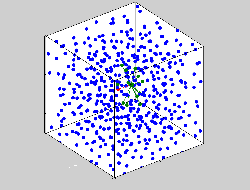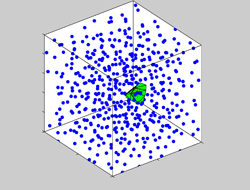

Spatial Analysis 3D
Spatial Analysis 3D is a user-friendly, graphical user interface (GUI) that allows statistical and visual manipulations of real and simulated three-dimensional spatial point patterns. Examples of the types of analyses performed include those derived from the Delaunay tessellation associated with such spatial point patterns, and those associated with the correlation of such point patterns, including autocorrelation analysis and its derived density recovery profile, as well as the related K, F, and G-functions. The stimulus for the development of Spatial Analysis 3D has been the study of neuronal positioning within the central nervous system, but many other applications in science, engineering, statistics and mathematics should benefit from this suite of programs.
Spatial Analysis 3D is the project of a collaborative research effort between Drs. Benjamin Reese, Mary Raven, and Dan Lofgreen at the Unversity of California at Santa Barbara and Dr. Stephen Eglen at the University of Cambridge. It has been supported by a grant from the National Institute of Mental Health through the Neurotechnology Research, Development and Enhancement Program. It grew out of our efforts to quantify the regularity and simulate the patterning found in distributions of nerve cells across the retina, a structure in the central nervous system where uniformity in nerve cell spacing plays a critical role in retinal function.
See:
Analysis of spatial relationships in three dimensions: tools for the study of nerve cell patterning.
Eglen SJ, Lofgreen DD, Raven MA, and Reese BE.
BMC Neurosci. 2008 Jul 21;9:68.In order to use Spatial Analysis 3D:
- You must have a computer running MatLab software
- You will need the following files:
- User guide (PDF or Word Document)
- SpatialAnalysis3d code (zip file)
- Installation File (Right click -> Save As; Windows only; matlab file)
- Install following the instructions in the User Guide
Error Reporting:
- Report bugs to dlofgreen1974@yahoo.com
- Use SpatialAnalysis in the subject
- Provide a description of the bug
- Provide steps on how to generate the bug when possible
- Copy and paste all the Matlab command window text related to last command
Funded by:
National Institute of Mental Health
(MH-069997)Benjamin E. Reese
University of California, Santa BarbaraStephen J. Eglen
University of CambridgeWritten by:
Dan Lofgreen
Channel Islands Consulting
Website created by Patrick Keeley and maintained by Caroline Ackley.
Copyright © 2015 The Regents of the University of California, All Rights Reserved.